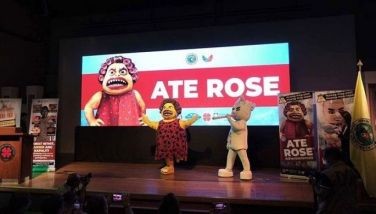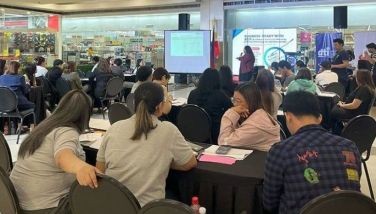‘Bay San Pedro
Executive Director, Dilaab Foundation Inc. (frmelodiola@gmail.com)
CEBU, Philippines - “Oh, what a coincidence, I am receiving a text for you,†Fr. Greg Gaston, amiable rector of the Collegio Filipino in Rome, told me when I chanced upon him at the porter’s room of the Collegio in the evening of Tuesday 22 October. Earlier, I had missed taking a flight to Cebu from Rome. Although scheduled for Friday with other pilgrims from my travel agency, I needed to go home earlier since my dearest mother, Elena, had died an hour after the Sunday canonization of the new Filipino saint, San Pedro Calungsod.
“Your travel agency informs you that you would have to take the Friday flight since Wednesday and Thursday are fully booked,†continued Fr. Greg. I then recalled that earlier I asked Fr. Charles “Cha-cha†Jayme, the travelling companion of the official statue of San Pedro, “What if I go with you?†in wistfulness.
That afternoon I decided to visit St. Peter’s Basilica one last time to pray before the monumental statue of St. Helena for the soul of my mother, her namesake. Going through the 1965 bronze door – “Door of the Sacraments†- I noticed Mass was going on at the other end of the basilica surrounding the “apse†(i.e. the semicircular area with a semi-dome as ceiling). There was a portable wooden fence to prevent tourists from entering the space to just take pictures.
“Vorrei pregare, per favore ,†I told the guard in a blue suit expressing my desire to pray. He let me in. I approached St. Helena’s statue and knelt down to pray the rosary alone. I then proceeded to another demarcated section and knelt in front of the tomb of Blessed John Paul II. Last stop was Michelangelo’s Pieta before exiting around 6:15 pm.
I felt greatly consoled.
* * *
The following morning, I concelebrated Mass at the Collegio. With my bags ready, I approached a Church leader to bless some religious articles. Archbishop Chito Tagle smilingly obliged. In a few hours, he – and others - would have another reason to smile.
By 8:30 am, Fr. Cha-cha was busy loading the statue of San Pedro into a specially-built capsule for the long journey back to the Philippines for the “Duaw-Nasud†(“Visiting the Nationâ€) ending the journey at the National Thanksgiving Mass in Cebu City on 30 November. This is 40 days after the canonization.
The statue arrived in the NCR on 25 October. It then proceeded to some cities in Northern Luzon until 7 November before travelling across Southern Luzon from 8-13 November. From there it went through Eastern Visayas from 13-15 November before proceeding to Caraga Region from 16-17 November. Then it was off to Northern Mindanao on 18 November, Western Mindanao on 19 November, and Zamboanga Peninsula 20 November. From Mindanao, it proceeded to Central and Western Visayas from 21-26 November before a three-day celebration in Cebu from 26 to 29 November, culminating in the National Thanksgiving Mass.
The Visayan lad is indeed making his rounds.
One reflects with awe and fascination at the metamorphosis of an ordinary piece of wood, initially transformed by the skillful hands of a Paete woodcarver, and how it has become an object of veneration. There are several layers to this veneration, called dulia to distinguish it from the worship (latria) due to Almighty God alone.
It is a symbol of San Pedro Calungsod whose canonization serves as a full-proof seal of his martyrdom for love of Christ. The statue participates in the honor given to San Pedro. Then, before being committed to the public, the statue is blessed; consecrating it to inspire faith. A third layer is the actual usage of the symbol among the faithful.
I participated in the constellation of liturgical celebrations featuring the statue: from the procession along a busy street of Rome near Sta. Prudenciana Church, the center for Filipino chaplaincy, to the Thanksgiving Mass inside St. Peter’s Basilica a day after the canonization. The statue was truly saturated by the collective and sanctifying prayers of believers.
* * *
We arrived at Rome’s Leonardo da Vinci airport and I assisted Fr. Cha-cha in carrying San Pedro’s capsule. Any impressions that Italians have become purely secular quickly disappeared. The airline staff, informed beforehand of their special guest, unabashedly displayed veneration for the saint.
Approaching the counter, I introduced myself and asked for a seat while mentioning about my ticket scheduled for Friday. “Yes, we can accommodate you,†was the quick reply. “What a wonderful gift from San Pedro,†I told myself trying to contain a yell. At that moment, San Pedro became my companion, rather than the other way around.
Before long, we were the first to board. As we approached the metal tube that connected to the plane, our Italian ground steward suddenly exclaimed, “What a rare sight!†It was a pettirosso, a robin. Our friend – with mouth and eyes wide open – informed us that this was molto strano (“very strangeâ€).
After hopping on the ground, the bird quickly flew into the tube as if leading us into the plane. At the juncture where the tube branched out in the direction either of the plane or the maintenance entrance, it chose the latter and disappeared from our sight.
We were provided very ample leg room inside the plane with the special capsule having its own seat, courtesy of an anonymous donor. It was actually standing before the seat, secured by a safety belt.
We were returning home to the Philippines with a very special companion.
* * *
The pettirosso a very common small European singing bird, often chubby and with no pronounced neck. It is usually found in gardens. Adults have a breast that has an orange color while the rest of the plumage is dark olive. Despite its small dimensions, it is known for its bold behavior. It is a lively bird, often following people in gardens to take advantage of the disturbed earth that yield worms, a favorite food. Its persistent and repeated call is heard all year round and even during nightfall.
According to a legend, the pettirosso obtained its orange chest from the spurt of blood from Jesus’ crown of thorns as the bird attempted to remove the crown with its beak as Jesus hang on the cross. Another legend has it as a symbol of the New Year, associating the robin with the passage from winter into the newness of spring.
The “Catechetical Primer on San Pedro Calungsod†describes the physical hardships of the Marianas mission. Still other missionaries remember “Pedro to be a boy with a very good disposition, a virtuous catechist, a faithful assistant, a good Catholic.†During those dark moments just prior to their martyrdom, to enable their would-be killers to cool down, we are told that “Padre Diego and Pedro gathered the children and some adults of the village at the nearby shore and started chanting with them the truths of the Catholic Faith.â€
Interestingly, the primer continues, the lack of definitive indicators about Pedro’s island of origin has a message: “For according to Fr. Ignacio Francisco Alcina, SJ, who worked in the Visayas during the time of Pedro, ‘bissaya’ means ‘a happy man’, ‘a man of fine and pleasant disposition.’ And this is how Pedro is described by his companions in their accounts of his martyrdom: that he was a lad of ‘very good disposition,’ and that he was a ‘fortunate [happy] youth’ because he lived and died for the Christian Faith.â€
Perhaps the pettirosso’s appearance was no mere coincidence.
* * *
The physical center of the 30 November National Thanksgiving Mass for San Pedro was the “templete†(Spanish for “a small templeâ€) at the South Road Projects of Cebu City, a pyramid-inspired structure symbolizing the “transcendence of faith†akin to San Pedro’s martyrdom. Beyond expectations, over a million pilgrims attended the event.
With “New Evangelization†as the catchword for the Year of Faith, and the Christian-Catholic faith facing many challenges – not the least the youth, who are “not turning away, they are simply not being reached†– from growing secularism, the national event could ignite new spaces of hope for Church and country.
San Pedro is truly a joyful, God-given “Bay†(Cebuano “Kaabay†or “companionâ€). Viva San Pedro – Mabuhi, ka!
- Latest































